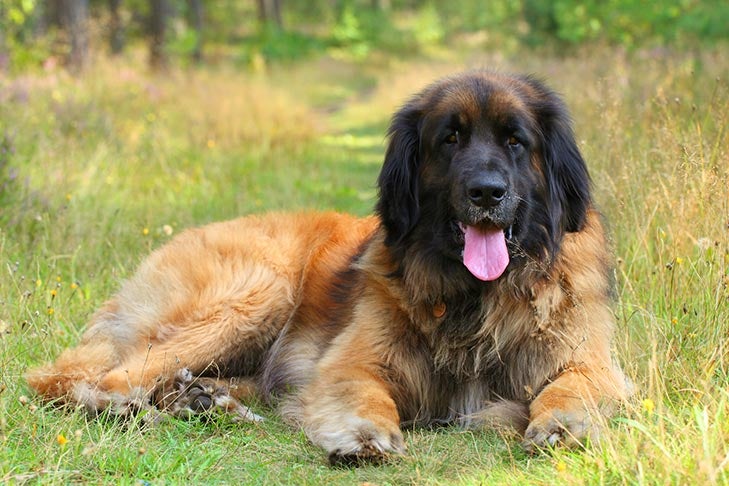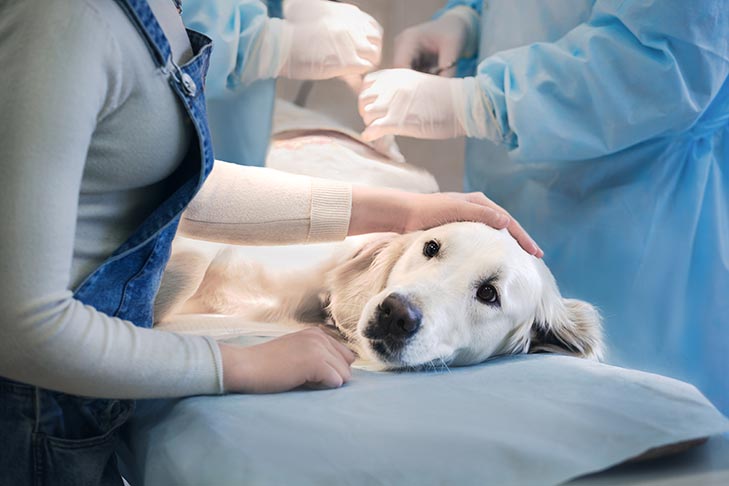If your dog develops cancer, it’s terrifying and overwhelming. At its most basic, cancer is the uncontrolled growth of cells, but the location of that growth and whether it has metastasized (spread to other parts of your dog’s body) make a huge difference.
There are so many questions about treatment, survival, and quality of life. Many of these concerns will depend on your dog’s specific diagnosis. However, as cancer is so common in dogs, it’s important to understand the basics of the disease, what signs to look for, and potential treatment options.
How Common is Cancer in Dogs?
According to Dr. Skylar Sylvester, DVM, DACVIM (Oncology), and Assistant Clinical Professor of Medical Oncology at Cornell University’s College of Veterinary Medicine, it’s estimated that about 30% of dogs, or one in three, will develop cancer in their lifetime. And the rate goes up as dogs age. In dogs older than 10, it’s closer to one in two, or 50%. Cancer is considered the leading cause of death in older dogs.
And it seems like canine cancer rates are on the rise. But are more dogs developing cancer, or is simply easier to diagnose the disease? It’s hard to say. Dr. Sylvester explains, “We do not have historical cancer registries for dogs, so we don’t know if the rates of cancer are truly increasing, or it just feels like we are diagnosing cancer more. Fortunately, we have made many advances in veterinary medicine that allow dogs to live longer, healthier lives and have improved our ability to diagnose and treat diseases. Since cancer is a disease of older age, for many dogs, living longer means living long enough to develop cancer.”

Are Certain Dogs More Likely to Get Cancer?
If cancer is more common in older dogs, that means age is a risk factor. But are there other factors? Unfortunately, yes. Certain dogs are more likely to get cancer or develop it at a younger age. A recent research study on age at cancer diagnosis by breed, weight, sex, and cancer type found that the median age of dogs for cancer diagnosis was 8.8 years. However, male dogs were diagnosed at younger ages than female dogs, and intact dogs at younger ages than neutered dogs. In addition, purebred and large breed dogs were diagnosed at younger ages than mixed-breed or smaller dogs.
Outside of age, a study by Nationwide Insurance that looked at cancer claims for 1.6 million dogs found that, as a group, purebred dogs have a relative cancer risk that is 1.9 times higher than mixed-breed dogs. The study also looked at the 25 most popular dog breeds and discovered cancer claims were filed most often for Boxers, Beagles, and Golden Retrievers. The fewest claims were filed for Chihuahuas, French Bulldogs, and Pomeranians.
Do Different Cancers Affect Different Breeds?
Many studies have found that some dog breeds have an increased risk of certain types of cancer, which suggests a genetic predisposition. For example, the Nationwide Insurance study above found that Boxers have a high relative risk for skin cancers, whereas Beagles are at greater risk of bladder cancer, among others. A literature review on breed predispositions to cancer found that osteosarcoma (a type of bone cancer) of the long bones almost exclusively affects large and giant breeds like Rottweilers, Great Danes, and Greyhounds.
Dr. Sylvester says, “Different breeds are predisposed to different specific cancer types, and veterinarians, scientists, breed clubs, and breeders are working hard to understand those genetic predispositions and hopefully, over time, reduce their cancer risk. In general, common breeds such as Golden Retrievers, Boxers, Rottweilers, Labrador Retrievers, German Shepherd Dogs, and Beagles appear to be overrepresented in the United States. Additionally, less common breeds and giant breeds such as Bernese Mountain Dog, Flat-Coated Retriever, Irish Water Spaniel, Spinone Italiano, Welsh Terrier, Vizsla, Irish Wolfhound, Leonberger, and Saint Bernard also appear to have higher mortality from cancer, especially in European studies.”

What Are the Most Common Types of Cancer in Dogs?
Although many types of cancer are categorized by the cells involved, Dr. Sylvester says some of the most common cancers in dogs include:
- Lymphoma (cancer of the lymphatic system)
- Mast cell tumors (mast cells are a type of white blood cell that plays a role in allergic response and is found in many different tissues in the body)
- Osteosarcoma (tumor in the bone)
- Oral malignant melanoma (tumor originating in the pigment-producing cells, known as melanocytes, inside the mouth)
- Hemangiosarcoma (cancer originating from the cells that line the blood vessels)
- Soft tissue sarcoma (cancer that arises from the connective, nervous, or muscle tissue, so can appear anywhere around the body)
What Are the Signs of Cancer in Dogs?
There are many different symptoms of cancer in dogs, depending on the location of the cancer and the type. However, there are some general signs of dog cancer that you should be aware of. Dr. Sylvester cautions that some dogs with cancer may show no signs of illness, but the following warning signs should prompt a visit to the vet:
- Lethargy, weakness, or decreased energy
- Changes in appetite, trouble eating, or unintentional weight loss
- Changes in bathroom habits like difficulty peeing or pooping
- Signs of pain such as limping
- Coughing or difficulty breathing
- Abnormal odors, bleeding, or discharge from any body openings such as the nose or mouth

And don’t forget about abnormal lumps, bumps, growths, or swellings. But what does a tumor look like on a dog? Dr. Sylvester says both benign (not cancerous) and malignant (cancerous) tumors can look identical, so the only way to truly tell them apart is to sample them. “In terms of lumps and bumps, any new mass, particularly ones that change in size or appearance, appear to be growing, irritate the pet, or become red or ulcerated, should be evaluated since those tend to be more concerning features,” she says.
How Is Cancer in Dogs Diagnosed?
Dr. Sylvester says for many cancers, diagnosis involves taking a sample of the tumor either through a fine-needle aspirate (using a thin needle to withdraw a small sample of cells) and cytology (examining a single cell or a small cluster of cells under a microscope). Another option is a tumor biopsy (removal of a representative sample of tissue) and histopathology (examining a solid piece of tissue which provides more information than cytology). “Looking at the cancer cells under the microscope can give us additional information about the tumor type and grade and often help us predict prognosis and how a particular cancer will behave.”
Dr. Sylvester adds that staging (determining how much cancer is in the dog’s body and where it may have spread) is an important step for determining the best treatment options. And that can involve more tests. “Staging involves assessing the extent of cancer spread within the body, typically with chest x-rays, abdominal ultrasound, or CT scan. Without this information, it can be difficult to know what treatment will be recommended for an individual pet at that point in time.” she says.
What Are Typical Treatments for Cancer in Dogs?
Cancer treatment depends on the type of cancer your dog has developed and the stage of the disease. However, for most dogs, treatment usually involves surgery to remove as much of the cancer as possible, radiation therapy to kill cancer cells with radiation, chemotherapy to kill cancer cells with drugs, or immunotherapy to boost the dog’s own immune system to fight the cancer. Your veterinarian may also use a combination of treatments, all with the goal of treating the local primary tumor as well as any potential spread. The cost of the treatment will vary widely depending on which treatments are used, how long your dog undergoes treatment, and your geographic location. Thankfully, pet insurance may cover some or all of the costs.
There are also innovative cancer treatments on the horizon, such as cancer vaccines and targeted drug treatments. In fact, there are currently three drugs with FDA approval for treating cancer in dogs and another with conditional approval. Two are for mast cell tumors, and two are for lymphoma.

Dr. Sylvester stresses that the goal of veterinary oncologists like herself is to help families understand their pet’s cancer diagnosis and navigate treatment options, all while ensuring their dog has the best quality of life they can. “Even if definitive cancer treatments, such as surgery, radiation therapy, or chemotherapy, are not pursued, there are palliative treatment options available to help dogs with cancer feel better and maintain good quality of life for as long as possible,” she explains.
Is It Possible to Prevent Your Dog From Getting Cancer?
With the high risk, you might be wondering how to prevent cancer in your dog. But what causes cancer in dogs? Unfortunately, many factors contribute to the development of cancer, such as genetic, environmental, and immunologic risk factors. “Evidence for a genetic cause of cancer can be seen in the breed predispositions to certain cancer types, but the majority of genetic changes that eventually lead to cancer occur through spontaneous mutations,” Dr. Sylvester explains. “There are also many environmental factors such as carcinogens, pesticides, UV light, pollution, hormones, and nutrition that may play a role in cancer risk.”
Therefore, due to the interplay of all those factors, there are currently no known ways to prevent most cancers or even predict which dogs will develop them and when. But that doesn’t mean you’re entirely at the mercy of the disease. Dr. Sylvester offers the following advice: “The best thing you can do is ensure your pet is otherwise healthy by seeing their veterinarian regularly, getting them exercise, feeding them a well-balanced diet, and ensuring they are well-loved, so that if they do develop cancer, they are in the best possible position to fight it.”








